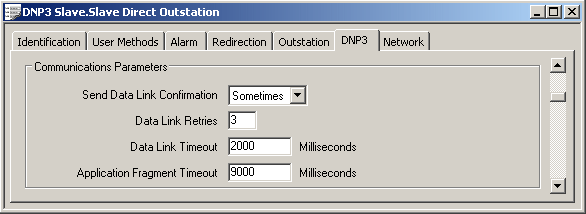Use this section on the DNP3 tab to specify the DNP3 Slave outstation’s Communications Parameters:

- Send Data Link Confirmation—Use this combo box to specify when the DNP3 master should send data link confirmations in response to unsolicited frames sent by the ClearSCADA slave outstation. Choose from:
- Never—The ClearSCADA slave outstation will not request data link confirmations. This is the recommended option unless the communications link between the master and slave is poor.
- Any configuration regarding Data Link Retries and Timeouts is ignored.
- Sometimes—The ClearSCADA slave outstation requests data link confirmations when the unsolicited message contains more than one DNP3 data link layer frame. If the unsolicited message contains only one frame, the ClearSCADA slave outstation does not request data link confirmations.
- Always—The ClearSCADA slave outstation requests data link confirmations for unsolicited messages with one or more DNP3 data link layer frames.
- Select this option if communications are unreliable—for example, devices operating in environments with high levels of interference.
- Data Link Retries—Applicable if Send Data Link Confirmation is set to an option other than ‘Never’. Use this field to specify the number of times that the ClearSCADA slave outstation is to re-send Data Link frames for which it has requested a confirm, but for which it does not receive a confirm within the Data Link Timeout.
- Data Link Timeout—Applicable if Send Data Link Confirmation is set to an option other than ‘Never’. Use this field to specify how long the ClearSCADA slave outstation is to wait for a Data Link confirmation from its DNP3 master, before re-sending the frame.
- Application Fragment Timeout—When a ClearSCADA slave outstation sends an unsolicited message to an DNP3 master, it expects a response. You can use the Application Fragment Timeout field to define the maximum amount of time the ClearSCADA slave will wait for the response from the DNP3 master (in milliseconds). If the DNP3 master does not reply within the Application Fragment Timeout period, the message is deemed to have failed. Multiple consecutive failures will cause the communications to fail.
If the ClearSCADA slave outstation does not receive the confirmation within the Data Link Timeout, the Data Link frame is re-sent. If the frame is not confirmed before the timeout of the last retry, the transmission of the frame is deemed to have failed.
When defining the Application Fragment Timeout period, you need to set a time that:
You should set the Application Fragment Timeout to at least:
((Data Link Retries + 1) * Data Link Timeout) + 1000
You may need to increase the timeout period if there are a significant number of timeouts.
For more information on the Application Fragment Timeout property, see Configure the Communications Parameters.